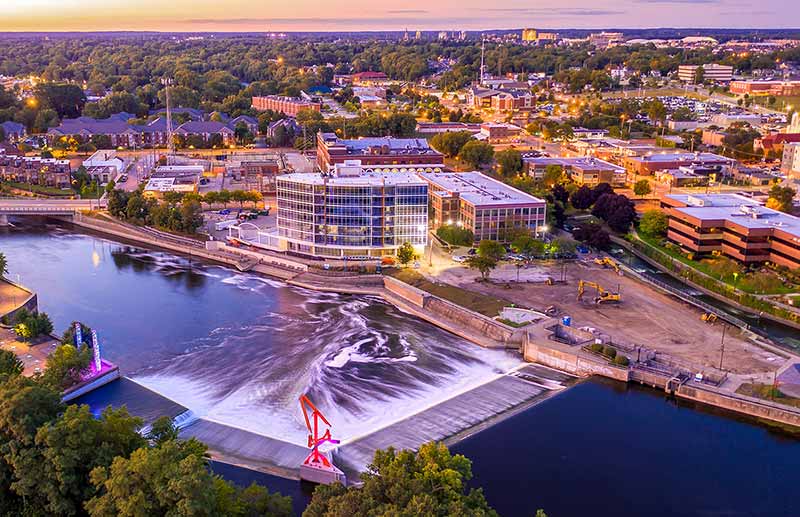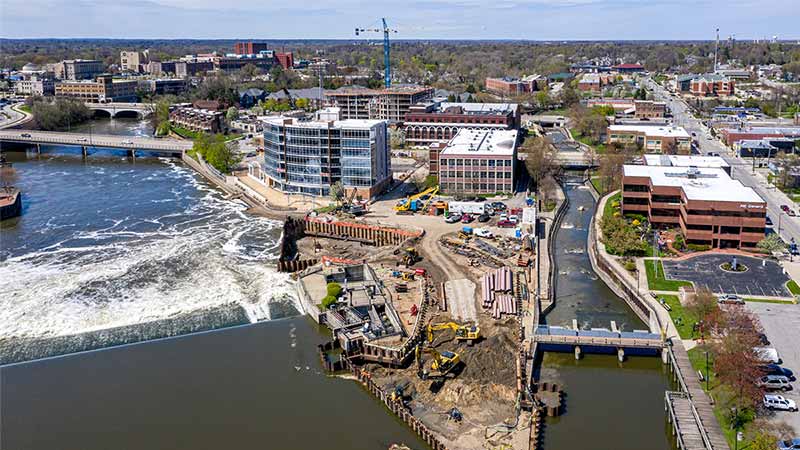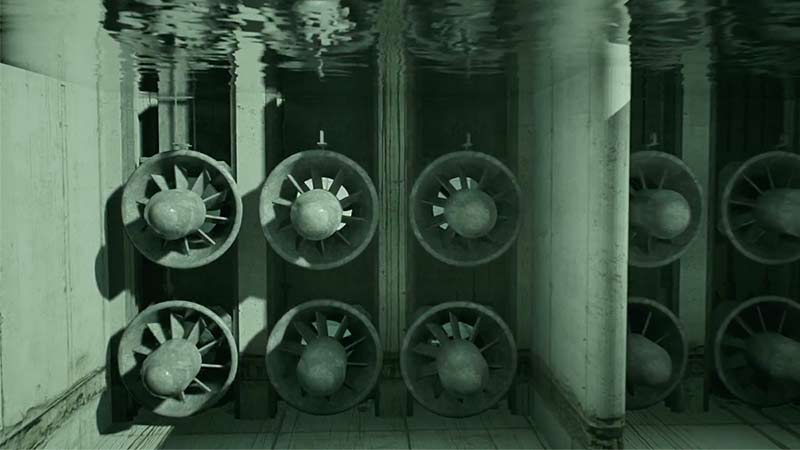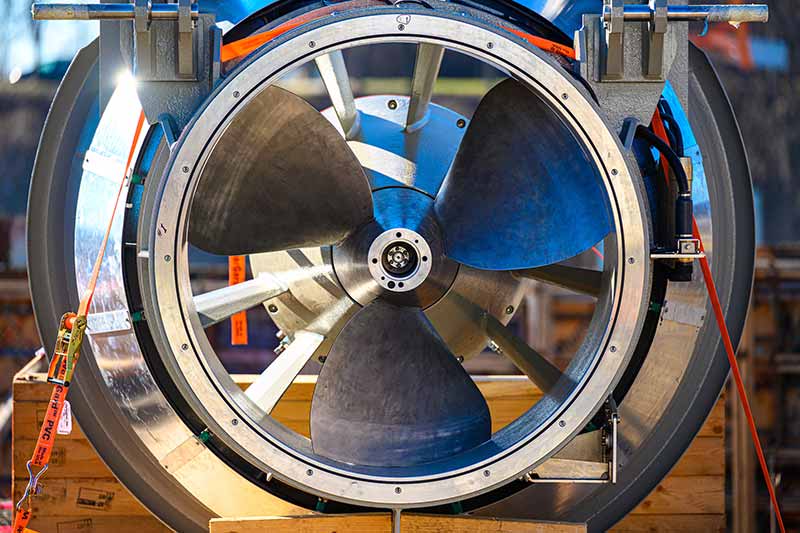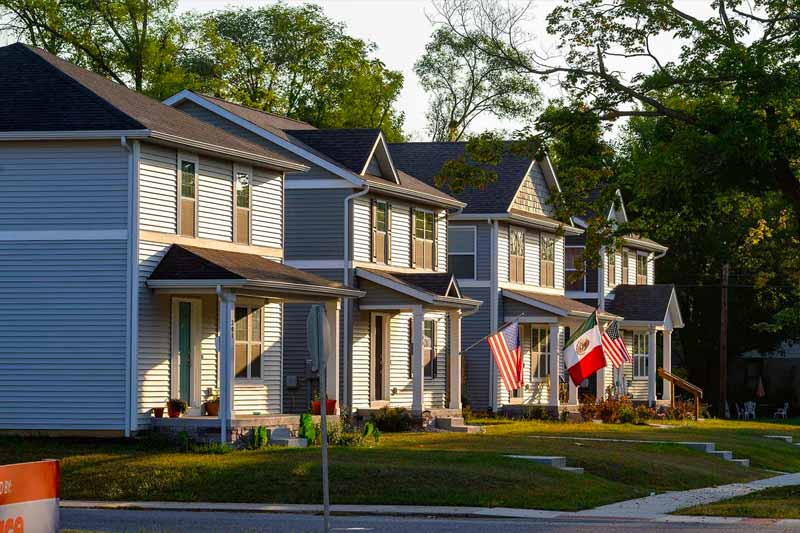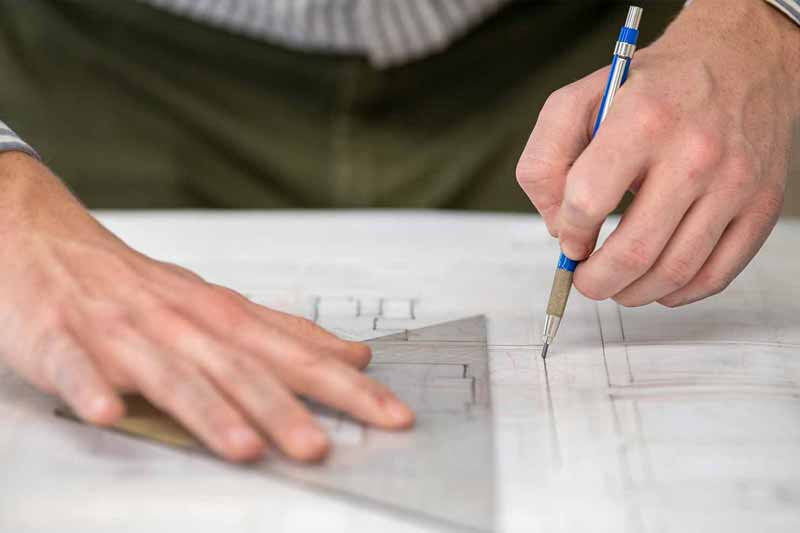The city of South Bend’s growth from a remote fur trading outpost to a thriving city, home to innovative industry and world-class colleges and universities, can be traced to its strategic location along the St. Joseph River.
Formed during the waning days of the last ice age, the 206-mile waterway, flowing in a westerly direction through southern Michigan and northern Indiana, was an important canoe route during pre-industrial times, linking Lake Michigan to the Mississippi watershed.
It also served as an important source of food and raw materials for Native and non-Native peoples, its floodwaters helping to enrich the surrounding soil and contribute to bountiful crops of maize, beans and squash.
Later, with the construction of a concrete and timber crib dam and two raceways, it helped to power early industry, including glass and textile manufacturing, facilitating the transition to an industrial economy and laying the groundwork for future growth.
This continued into the 20th century, when the river was used to produce hydroelectricity for manufacturing and, later, cooling water for a coal-powered energy plant housed in the present-day Commerce Center, a Beaux Arts-style building constructed for the Indiana and Michigan Electric Company, precursor to Indiana Michigan Power, and completed in 1911.
But as industry moved away from the river in search of cheaper and more abundant land, concern for the waterway as an economic asset — not to mention an environmental resource — faded, with devastating consequences.
At the lowest point, the area’s single most defining feature, the source of its name and fame, functioned as little more than an open sewer, channeling human and industrial waste downstream toward Lake Michigan.
This persisted into the 1970s, when, motivated by the environmental movement and a flood of federal money for economic and community development — so-called “urban renewal” — people returned to the idea of the river as a vital economic asset, worthy of a place of prominence in a rejuvenated downtown.
Over time, the east and west raceways were redeveloped, the former as a whitewater rafting course and the latter as a water feature for the city’s new convention center. The dam became the focal point of a rejuvenated riverfront, with parks, pathways and public art including River Lights, an interactive light sculpture.
Still, the use of the river as a source of power — at least downtown and with the existing infrastructure there — remained a thing of the past.
Until now.
Harnessing the River
In partnership with the city of South Bend, the University of Notre Dame recently dedicated a new hydroelectric facility along the river at Seitz Park — near the mouth of the east raceway and in the shadow of former industry, including one of the few surviving mill structures in the area, the former Stephenson Underwear Mills. Indiana Michigan Power also played a key role in working collaboratively with Notre Dame on a joint transmission line route that consolidated two infrastructure projects for efficiency sake and followed a path around downtown that had been envisioned initially by Notre Dame to bring the power of the hydroelectric facility back to its campus.
“Today we move another step closer to our sustainability goals with construction of this facility. We are grateful to the city of South Bend and all of our partners who are helping us harness the power of the St. Joseph River to bring clean, renewable energy to Notre Dame.” —Rev. John I. Jenkins, C.S.C.
At a groundbreaking ceremony for the facility back in 2019, Notre Dame President Rev. John I. Jenkins, C.S.C., speaking above the rush of water over the sloping, L-shaped dam, framed the project as yet another step in the University’s ongoing march toward sustainability.
“In 2015, inspired and guided by Pope Francis’ encyclical Laudato Si’, Notre Dame renewed our commitment to reduce the University’s carbon emissions and join others in becoming better stewards of the Earth, our common home,” Father Jenkins said. “Today we move another step closer to our sustainability goals with construction of this facility. We are grateful to the city of South Bend and all of our partners who are helping us harness the power of the St. Joseph River to bring clean, renewable energy to Notre Dame.”
For his part, current U.S. Transportation Secretary Pete Buttigieg, then mayor of South Bend, said, “This project speaks to a number of city priorities, including our commitment to sustainability, our ongoing improvements to the South Bend parks and trails systems and our strong partnership with the University of Notre Dame. It is another boost to the East Bank’s renaissance and helps mark the St. Joseph River as a key downtown asset.”
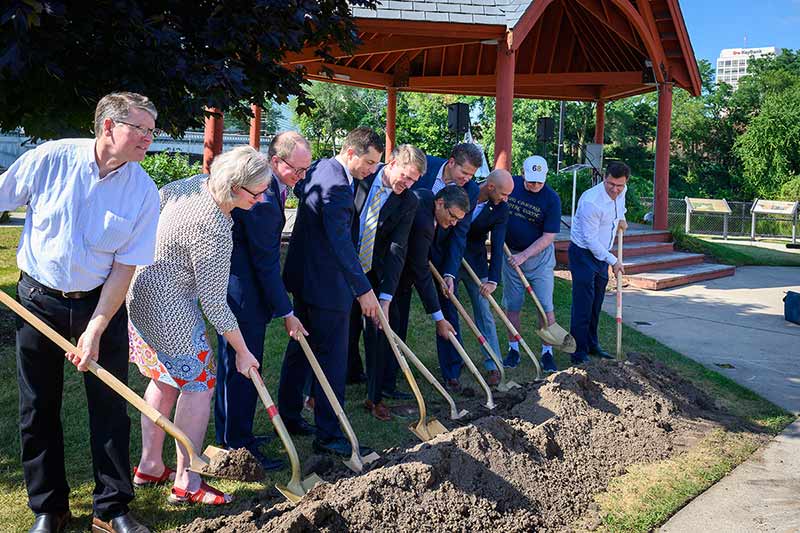
Situated on the east side of the river beneath Seitz Park, the 2.5-megawatt facility harnesses the power of the river and is expected to produce about 7 percent of the electricity for campus and offset about 9,700 tons of CO2 emissions annually.
For Notre Dame, it is the latest in a series of investments designed to reduce carbon emissions campus-wide, consistent with the University’s Catholic mission and values and the Pope’s encyclical, which calls for “swift and unified global action” to slow or stop global temperature rise for the good of “our common home.”
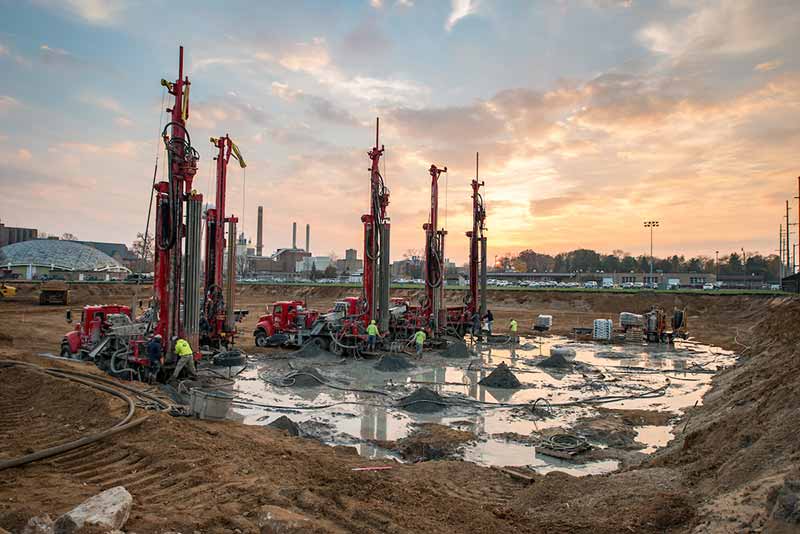
In the past several years alone, Notre Dame has added solar and geothermal heating and cooling to its energy mix, transitioned from coal to cleaner-burning natural gas as the primary source of fuel for campus, launched a food-to-energy program and collaborated with local partners to reduce food waste and support food programs for children and adults in the South Bend area.
Speaking at the opening of the 2021-22 Notre Dame Forum — the theme, “Care for Our Common Home: Just Transition to a Sustainable Future,” centered on climate change — Father Jenkins outlined even more ambitious climate goals for the University moving forward.
“The use of more geothermal, large-scale solar arrays, hydroelectricity, recovered energy, conservation and other emerging technologies and fuel sources will hopefully get us to a 65 percent reduction in CO2 by 2030, and to zero net neutral carbon emissions 20 years later,” Father Jenkins said while introducing NBC News correspondent and Notre Dame alumna Anne Thompson and U.S. Sen. Chris Coons at the event.
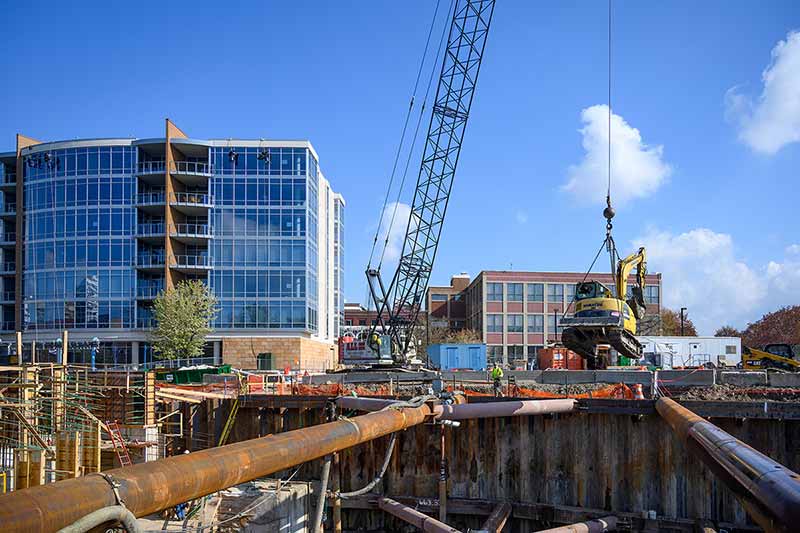
This corresponds with a global push for climate action amid rising energy prices and increasing awareness of the effects of climate change on human health and the environment, from rising sea levels and more intense heat waves to more flooding and poorer and less reliable air and water quality.
“Developed in close collaboration with the city of South Bend and other community partners, this facility, powered by the St. Joseph River, is yet another example of Notre Dame’s ongoing commitment to sustainability — specifically, the cultivation of new and innovative sources of clean, renewable energy,” Father Jenkins said more recently. “As the latest in a growing portfolio of green energy projects for Notre Dame, it will offset nearly 9,700 tons of heat-trapping carbon dioxide annually, helping us to achieve the ultimate goal of a carbon neutral campus by 2050.”
A Complex Project
Still, the journey to this point has been a long one, beset by unexpected hurdles and unforeseen planning and logistical delays.
The idea of restoring the dam to its original use as a source of hydroelectric power dates back to at least 1980, when South Bend applied for and received a license exemption from the Federal Energy Regulatory Commission to develop and operate a hydro facility at Seitz Park. The plan was for a small-scale facility to power nearby Howard Park or supplement the grid. But the combination of low global energy prices and an unfavorable regulatory environment for green energy projects in Indiana ultimately doomed the project.
“We were very interested in seeing hydroelectricity in the city because it’s a clean source of energy that reduces the community’s carbon footprint,” said Eric Horvath, director of public works for the city and a Notre Dame graduate, but “it just wasn’t financially feasible.”
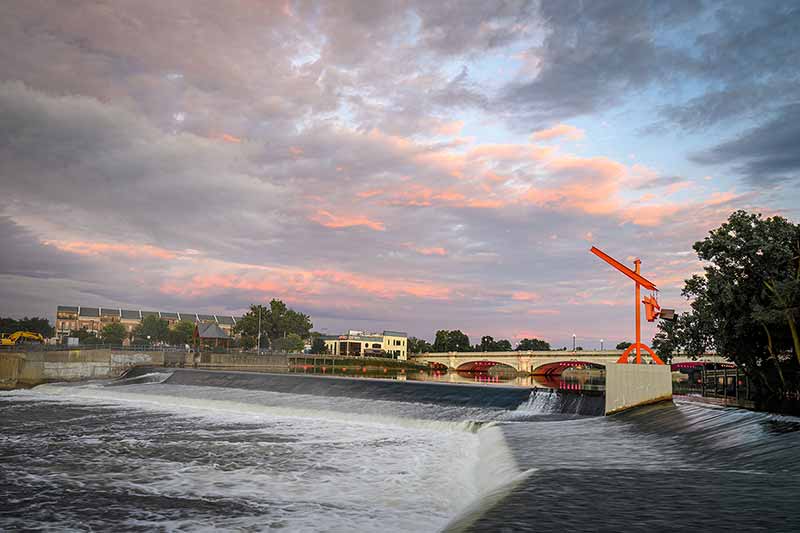
At risk of losing the license exemption for lack of use, the city, in 2016, transferred it to Notre Dame.
Not coincidentally, the University had recently adopted a new sustainability strategy outlining “continued actions and aspirations” in six separate areas: energy and emissions, water, building and construction, waste, procurement, licensing and food sourcing, and education, research and community outreach.
The city granted the University a 50-year lease to develop and operate a hydro project at Seitz Park. In exchange, the University agreed to contribute $1 million toward the restoration of the park, which was already due for upgrades as part of a comprehensive citywide parks plan. The University also helped to rebuild a seawall for the park. And it designed the facility to accommodate an overlook at the park.
As part of the original license exemption a requirement was to preserve first water rights for the existing assets there, the agreement preserved the flow of water to the east and west raceways and over the cascade (dam). It also preserved the flow of water to the fish ladder at Seitz Park, which is critical for the movement of salmon and trout both downstream and upstream from Lake Michigan to the Bodine State Fish Hatchery in Mishawaka.
Next came the complex task of planning and designing the facility, involving a number of stakeholders and regulators at the local, state and federal levels. A team of design professionals, contractors, suppliers worked collaboratively as well as with nearby property owners, whose cooperation was necessary to not only access the site but run the transmission line north to campus.
“We had to deal with FERC, we had to deal with the (Indiana) Department of Environmental Management, the Indiana Department of Natural Resources, U.S. Fish and Wildlife, the Army Corps of Engineers, the city, the neighbors. I mean, the list goes on,” said Paul Kempf, assistant vice president for utilities and maintenance at Notre Dame, who helped shepherd the project from idea to completion.
Early on, Kempf and a group of colleagues traveled to Austria to meet with Voith Hydro, the turbine supplier whose innovative StreamDiver design was determined to be best suited for this project. Based on the characteristics of the site, including the flow of the river and the height of the dam, our consultant team of KFI Engineers and Lawson-Fisher Associates designed a 10-turbine system capable of generating as much as 2.5 megawatts of electricity, or enough to power between 1,750 and 2,500 homes.
Work on the project commenced in August 2019 and continued for nearly three years, through multiple delays.
‘A Great Collaboration’
To start with, crews drove sheeting around the entire work area including in the river at the intake and outlet of the planned facility. Dewatering followed to allow for excavations that ranged from 20 to over 40 feet below grade level to accommodate the massive tunnels needed to divert water from the river to the powerhouse as well as the construction of a dam to support the new turbines, unearthing bricks and other debris in the process — detritus from decades of development along the river bank.
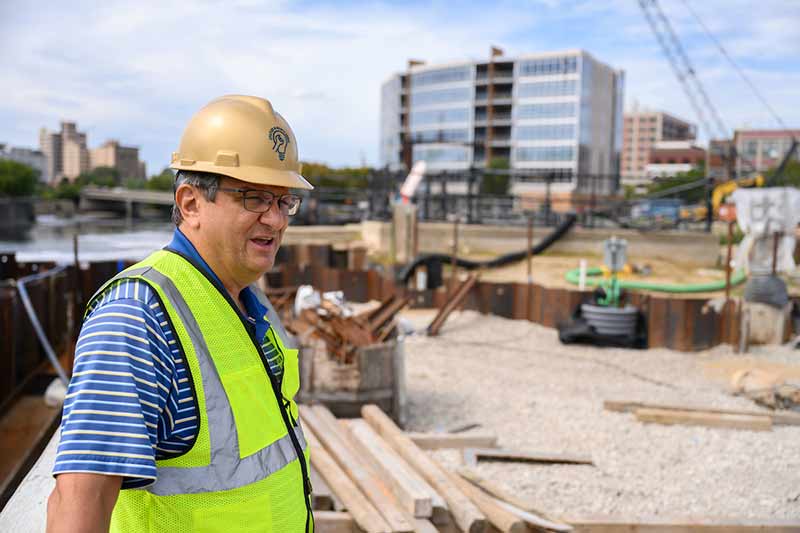
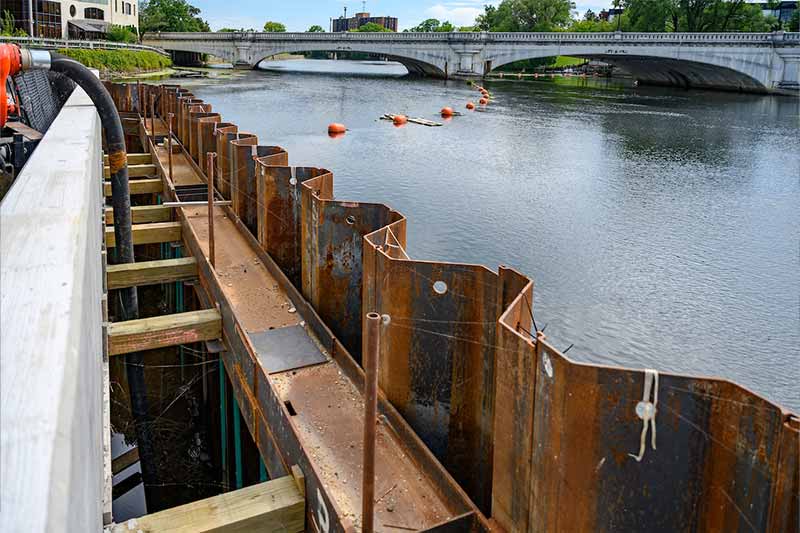
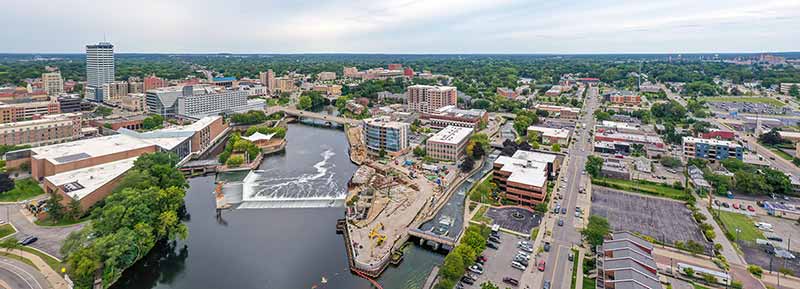
“If you look at any of the old plat maps, this whole area, both sides of the river, was just littered with all these little industries,” Kempf said while walking around the site last September, workers hoisting materials and placing rebar in the cavernous pit below. “And then 20 or 30 years go by and you look at another map and it’s a whole bunch of different people. So it was torn down, built up, torn down, built up. And back in those days when they were finished with a building they just shoved it in a hole and buried it. So we exposed a lot of debris.”
Construction involved 6,700 cubic yards of poured and pre-cast concrete, including a series of 25,000-pound box culverts measuring 16 feet wide by 14 feet tall. The foundation alone required six feet of concrete, including a two-foot mud slab, to prevent water and moisture from undermining the foundation. The facility contains 1.1 million pounds of steel.
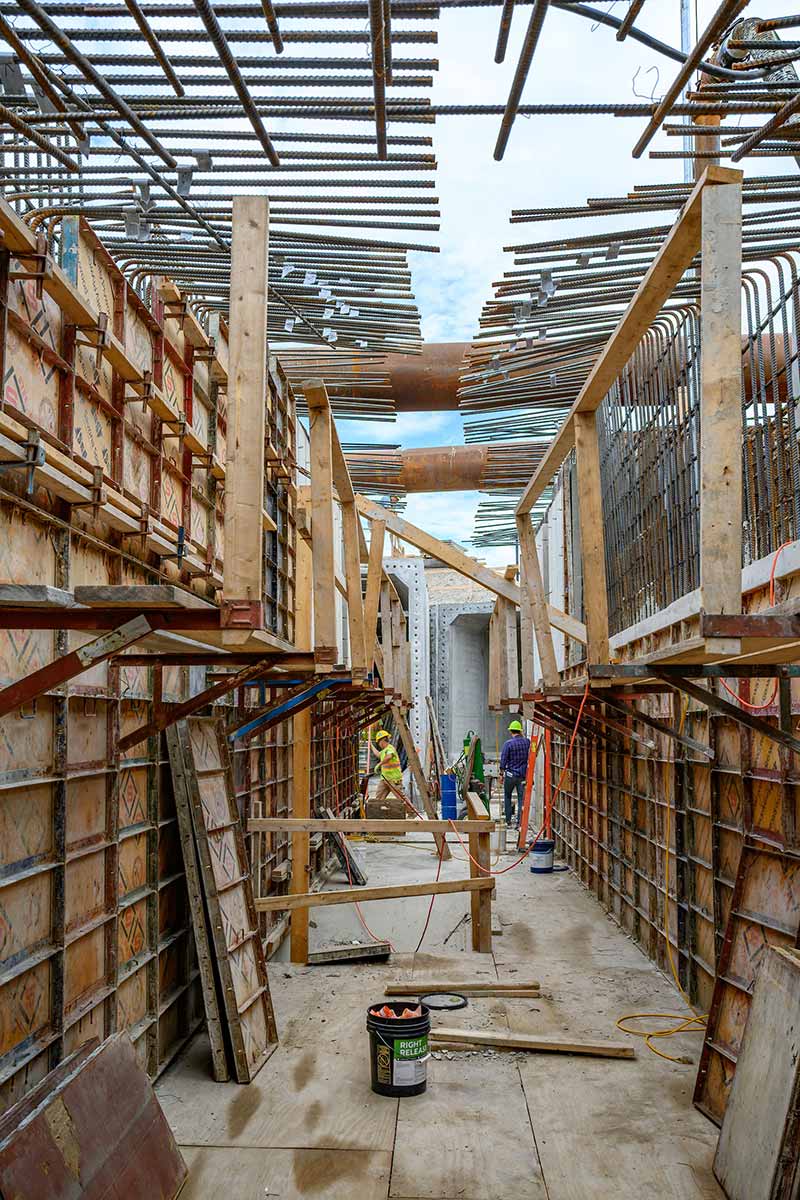
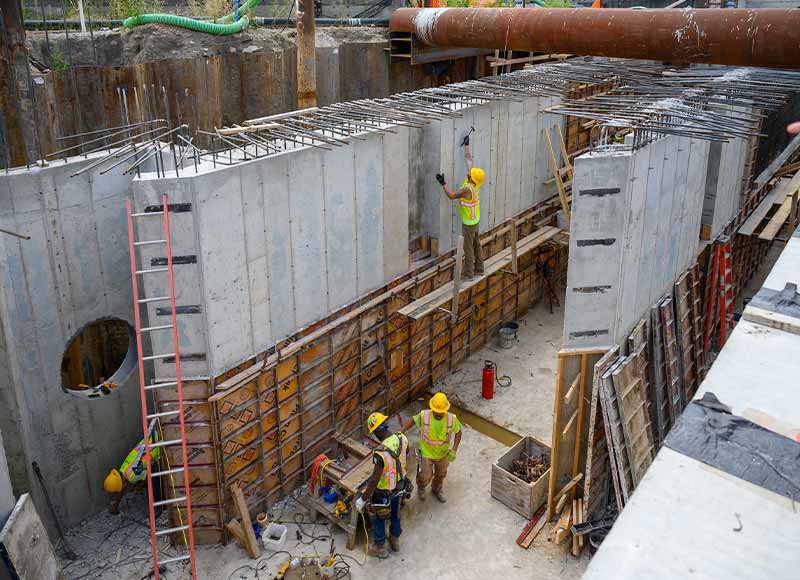
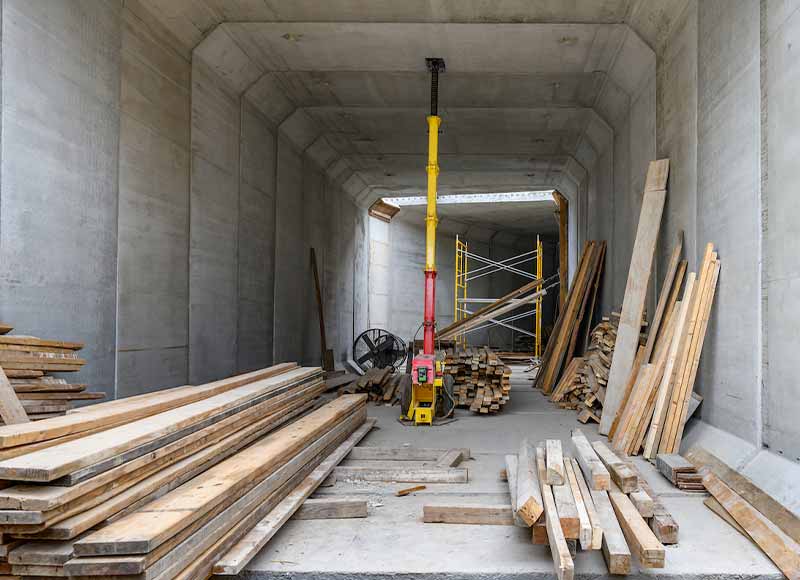
Work concluded and the facility was commissioned in May. It has been generating clean, renewable and reliable power for campus ever since.
“It’s been running seven turbines out of 10 based on the river level for about a week now,” Kempf said in early June. “And it’s consistent,” he said, unlike wind or solar, which depend on weather and time of day. “It runs day and night, night and day.”
“It’s been a great collaboration,” Horvath, the director of public works for the city, said. “Both sides will see benefits.”
As a Catholic institution, the University is morally obligated to care for the planet regardless of the cost, both out of respect for God’s creation and concern for human health and the environment.
From a purely financial perspective, the University expects a 30-year return on the project, Kempf said. He admits that’s long for a project of this scale. But it’s still shorter than the average lifespan for a hydro project. The Hoover Dam in Nevada has been producing power since 1936. The Twin Branch Dam in Mishawaka, about 9 miles from campus, has been turning water into watts for more than 100 years.
“Notre Dame is probably the only entity in town that could have pulled this off,” Horvath said, “because there’s a lot of upfront investment, plus a substantial investment to route the main power line from the facility to the University.”
But it’s about more than dollars and cents, Kempf said. As a Catholic institution, the University is morally obligated to care for the planet regardless of the cost, both out of respect for God’s creation and concern for human health and the environment.
“We’re in it for the long haul,” Kempf said.
The facility is unique among hydro plants in Indiana in that it is the only small-scale plant (less than about 30 megawatts) in the state, according to the National Hydropower Association. It is also the only hydro facility in the state that is not owned by a public utility.
In that sense, “It shows a lot of commitment (on the part of the University) to physically reduce carbon emissions to the best of our ability,” Kempf said.
Benefits ‘For Generations’
Tucked neatly beneath Seitz Park, the facility consists of 10 turbines, each with a 250-kilowatt generator and a propeller type runner, stacked two-high across five shafts. Water from the intake tunnels turns the runner, activating the generator and pushing clean, renewable energy up the east bank of the river to campus. The water then flows back to the river at a point just below the dam.
From an operational standpoint, the facility is very much hands off. As water flows into the intake tunnels, it is filtered through a screen, or trash rack, to remove branches and other large debris. Farther along, a second rack removes fine debris, such as leaves. A large arm sweeps the screen every so often to keep it clean. From there, an automated system controls the flow of water to the powerhouse and activates or deactivates the turbines based on water level, which ebbs and flows throughout the year. The turbines use water for cooling and lubrication, avoiding the use of oil. A bypass tunnel allows wayward fish to travel safely up- or downstream through the facility while avoiding the turbines.
Should maintenance become an issue, the turbines can be removed and repaired or replaced via a rail system, with no need to dewater the plant.
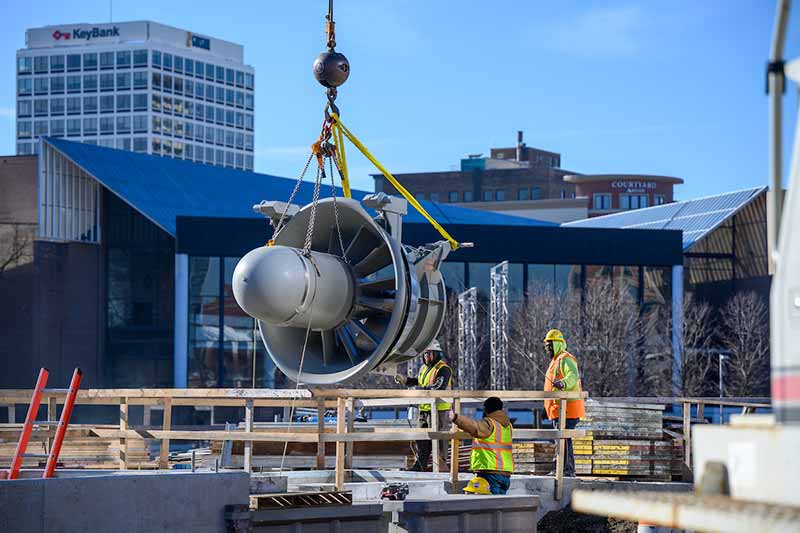
“It’s really meant to operate automatically, all by itself,” Kempf said. “It’s something we really don’t have to touch.”
The facility was also designed with an opening in the wall of the intake tunnel, downstream from the trash racks, to supplement the flow of clean (see: debris-free) water to the fish ladder, which tends to clog upstream.
This was done to assist the DNR who in the past has spent considerable time and resources keeping the flow of water to the fish ladder moving smoothly.
“The way it was set up before, the flow that went into the fish ladder came from upstream farther, and all the debris that came out of the river would plug it,” Kempf said. “So we said, ‘Well, we’ll put your attraction flow behind our screen, so it won’t plug it and you won’t have to come down here and clean it all the time.’”
Time will tell, but the facility may help to reduce turbulence and improve water quality downstream, as well, Kempf said, assuming the outflow acts as a stabilizing influence on the dam, whose churning waters disturb the riverbed and due to the angled west end has pushed water against the east shore and portage. So far the hydro operation seems to counterbalance this flow and has essentially straightened back out the river flow.
Beyond that, the University hopes to use the facility for education and research, Kempf said. Engineering students, along with a number of Montessori and homeschool students, already toured the site during construction, he said. Looking ahead, he sees an opportunity for biology students to partner with the DNR on a fish study there. He also sees an opportunity for educational signage tracing the history of the site from the 1840s, when the dam was completed and industry moved in, until today, and providing information about the current facility and its role as source of clean, renewable energy for Notre Dame.
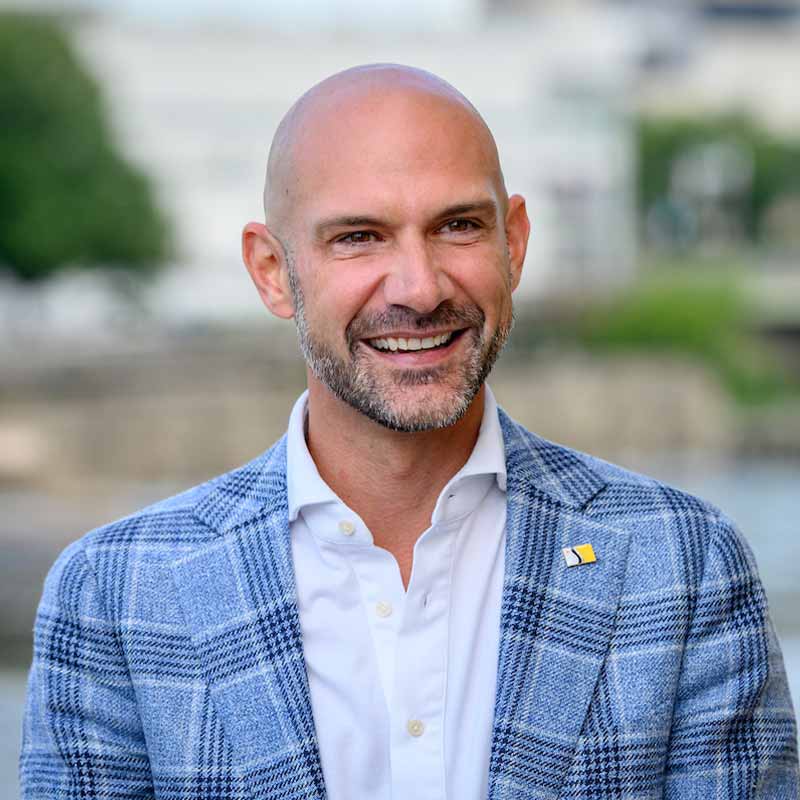
“Anytime we get to partner with the University of Notre Dame on a project, we know it’s going to be done right; Notre Dame doesn’t cut corners. So in that respect, it’s been a wonderful partnership, one that will benefit both the city and Notre Dame for generations to come.” —Aaron Perri
In the meantime, the city is already busy preparing for the new Seitz Park. Plans call for an additional entrance, a new performance area, improvements to the East Race bridge and promenade and a new public building with bathrooms and space for sales — critical updates for what Aaron Perri, executive director of Venues Parks and Arts, describes as the most popular park “pound for pound, acre for acre” in the entire city.
“We think it’s about a year-long construction project,” Perri said. “So by next summer, the summer of ’23, we should be cutting the ribbon on Seitz Park.”
Perri, who has two degrees from Notre Dame, said it was a challenge designing the park around the hydro facility. But it gave the city an opportunity to “think a little bit bigger” about the project.
For one, he said, it provided a blank slate for the project and a $1 million starting budget. It also expanded the footprint of the park at no cost to the city. And at just 4.2 acres, every square foot counts.
“It’s been a challenging project. It’s a complex site with a complex set of considerations,” Perri said. “But anytime we get to partner with the University of Notre Dame on a project, we know it’s going to be done right; Notre Dame doesn’t cut corners. So in that respect, it’s been a wonderful partnership, one that will benefit both the city and Notre Dame for generations to come.”
